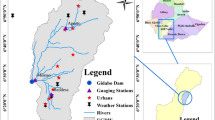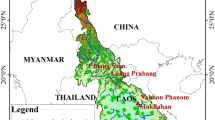Abstract
In this study, the existing empirical models for sediment management for ungauged watersheds in South Korea developed in 2019 were updated. The existing models were developed based on the Universal Soil Loss Equation structure with domestic river sediment data obtained from 2005 to 2014 and watershed characteristic values. To update the models, the specific degradation (SD) value was calculated first in the same way as the existing method by adding sediment measurement and daily discharge data obtained from 2015 to 2020. The calculated SD values with recent data decreased compared with the past and differed from the results predicted using the existing models and the watershed characteristics investigated in this study. For this reason, the existing models were updated using the latest watershed characteristics and SD values. The root-mean-square error values of the existing models, which ranged from 131 to 90 tons/km2·year, decreased to 102 to 62 tons/km2·year in the updated models with the same structures. Multicollinearity was tested to evaluate the reliability of the updated models, and a new 95% prediction interval for usability was estimated. In addition, quantitative changes in the future sediment load of domestic rivers were analyzed using the future rainfall data obtained from climatic change scenarios and the watershed area. The results of this study reconfirmed that periodic updates are required for the existing empirical models. It is expected that the empirical models will be used in various ways, such as for the prediction of future sediment loads for river sediment management.
Similar content being viewed by others
References
Christensen JH, Carter TR, Rummukainen M, Amanatidis G (2007) Evaluating the performance and utility of regional climate models: The PRUDENCE project. Climatic Change 81(1):1–6, DOI: https://doi.org/10.1007/s10584-006-9211-6
Faran Ali K, De Boer DH (2008) Factors controlling specific sediment yield in the Upper Indus River basin, northern Pakistan. Hydrological Processes 22(16):3102–3114, DOI: https://doi.org/10.1002/hyp.6896
Giorgi F, Jones C, Asrar GR (2009) Addressing climate information needs at the regional level: The CORDEX framework. World Meteorological Organization (WMO) Bulletin 58(3):175
Jin CS, Cha DH, Lee DK, Suh MS, Hong SY, Kang HS, Ho CH (2016) Evaluation of climatological tropical cyclone activity over the western North Pacific in the CORDEX-East Asia multi-RCM simulations. Climate Dynamics 47(3):765–778, DOI: https://doi.org/10.1007/s00382-015-2869-6
Julien PY (2010) Erosion and sedimentation. Cambridge University Press, Cambridge, UK
Julien PY (2018) River mechanics. Cambridge University Press, Cambridge, UK
Kane B, Julien P (2007) Specific degradation of watersheds. International Journal of Sediment Research 22(2):114–119
Kang W, Jang EK, Yang CY, Julien PY (2021) Geospatial analysis and model development for specific degradation in South Korea using model tree data mining. Catena 200:105142, DOI: https://doi.org/10.1016/j.catena.2021.105142
Kang W, Lee K, Jang EK (2022a) Evaluation and validation of estimated sediment yield and transport model developed with model tree technique. Applied Sciences 12(3):1119, DOI: https://doi.org/10.3390/app12031119
Kang W, Lee K, Kim J (2022b) Prediction of suspended sediment concentration based on the turbidity-concentration relationship determined via underwater image analysis. Applied Sciences 12(12): 6125, DOI: https://doi.org/10.3390/app12126125
Kang W, Yang CY, Lee J, Julien PY (2019) Sediment yield for ungauged watersheds in South Korea. KSCE Journal of Civil Engineering 23(12):5109–5120, DOI: https://doi.org/10.1007/s12205-019-0085-3
Kutner MH, Kutner MH, Nachtsheim C, Neter J (2004) Student solutions manual for use with applied linear regression models. McGraw-Hill/Irwin
Langbein WB, Schumm SA (1958) Yield of sediment in relation to mean annual precipitation. Eos Transactions Americal Geophysical Union 39(6):1076–1084, DOI: https://doi.org/10.1029/TR039i006p01076
Lee JH, Heo JH (2011) Evaluation of estimation methods for rainfall erosivity based on annual precipitation in Korea. Journal of Hydrology 409(1–2):30–48, DOI: https://doi.org/10.1016/j.jhydrol.2011.07.031
Lee JH, Lee JH, Julien PY (2018) Global climate teleconnection with rainfall erosivity in South Korea. Catena 167:28–43, DOI: https://doi.org/10.1016/j.catena.2018.03.008
Merritt WS, Letcher RA, Jakeman AJ (2003) A review of erosion and sediment transport models. Environmental Modelling and Software 18(8–9):761–799, DOI: https://doi.org/10.1016/S1364-8152(03)00078-1
Milliman JD, Syvitski JP (1992) Geomorphic/tectonic control of sediment discharge to the ocean: The importance of small mountainous rivers. The Journal of Geology 100(5):525–544, DOI: https://doi.org/10.1086/629606
MOC (1992) Research of sediment yield rate for dam design, Retrieved from KR: Ministry of Construction
MOC (2011) Dam design manual and analysis, Retrieved from KR: Ministry of Construction
NGII (2020) The National Atlas of Korea II 2020, Retrieved from KR: National Geographic Information Institute
Phan DB, Wu CC, Hsieh SC (2011) Impact of climate change on stream discharge and sediment yield in Northern Viet Nam. Water Resources 38(6):827–836, DOI: https://doi.org/10.1134/S0097807811060133
Prosser IP, Young WJ, Rustomji P, Hughes AO, Moran CJ (2001) A model of river sediment budgets as an element of river health assessment. Proceedings of the international congress on modelling and simulation (MODSIM’2001), 861–866
Sellar AA, Jones CG, Mulcahy J, Tang Y, Yool A, Wiltshire A, O’Connor FM, Stringer M, Hill R, Palmieri J, Woodward S, de Mora L, Kuhlbrodt T, Rumbold S, Kelley D, Ellis R, Johnson C, Walton J, Abraham N, Andrews M, Andrews T, Archibald A, Berthou S, Burke E, Blockley E, Carslaw K, Dalvi M, Edwards J, Folberth G, Gedney N, Griffiths P, Harper A, Hendry M, Hewitt M, Johnson B, Jones A, Jones C, Keeble J, Liddicoat S, Morgenstern O, Parker R, Predoi V, Robertson E, Siahaan A, Smith R, Swaminathan R, Woodhouse M, Zeng G, Zerroukat M (2019) UKESM1: Description and evaluation of the UK earth system model. Journal of Advances in Modeling Earth Systems 11(12):4513–4558, DOI: https://doi.org/10.1029/2019MS001739
Shrestha B, Babel MS, Maskey S, Van Griensven A, Uhlenbrook S, Green A, Akkharath I (2013) Impact of climate change on sediment yield in the Mekong River basin: A case study of the Nam Ou basin, Lao PDR. Hydrology and Earth System Sciences 17(1):1–20, DOI: https://doi.org/10.5194/hess-17-1-2013
Vente J, Verduyn R, Verstraeten G, Vanmaercke M, Poesen J (2011) Factors controlling sediment yield at the catchment scale in NW Mediterranean geoecosystems. Journal of Soils and Sediments 11(4):690–707, DOI: https://doi.org/10.1007/s11368-011-0346-3
Wheater HS, Jakeman AJ, Beven KJ (1993) Progress and directions in rainfall-runoff modelling. Modelling Change in Environmental Systems, Wiley, Chichester, 101–1322
Yang CY, Kang W, Lee JH, Julien PY (2022) Sediment regimes in South Korea. River Research and Applications 38(2):209–221, DOI:https://doi.org/10.1002/rra.3896
Yoon YN (1981) Estimation of silting load and capacity loss rate of irrigation revervoirs. KSCE Journal of Civil and Environmental Engineering Research 1(1):69–76
Yoon B, Woo H (2000) Sediment problems in Korea. Journal of Hydraulic Engineering 126(7):486–491, DOI: https://doi.org/10.1061/(asce)0733-9429(2000)126:7(486)
You SC, Min BH (1975) A study for sedimentation in reservoir -on district of Chin Young. Journal of the Korean Society of Agricultural Engineers 17(3):46–53
Acknowledgments
This research was supported by Korea Institute of Marine Science & Technology Promotion (KIMST) funded by the Ministry of Oceans and Fisheries (00256687).
Author information
Authors and Affiliations
Corresponding author
Rights and permissions
About this article
Cite this article
Kang, W., So, Bj., Kim, S. et al. Update of Empirical Models for Predicting Specific Degradation in South Korea and Future Sediment Management Considering Climate Change. KSCE J Civ Eng 28, 186–196 (2024). https://doi.org/10.1007/s12205-023-0220-z
Received:
Accepted:
Published:
Issue Date:
DOI: https://doi.org/10.1007/s12205-023-0220-z




